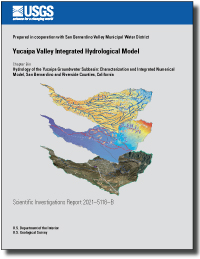Yucaipa Valley Integrated Hydrological Model
Links
- Document: Report (15 MB pdf) , XML
- Larger Work: This publication is Chapter B of Hydrology of the Yucaipa groundwater subbasin: Characterization and integrated numerical model, San Bernardino and Riverside Counties, California
- Related Work: SIR 2021-5118 Chapter A - Hydrogeologic Characterization of the Yucaipa Groundwater Subbasin
- Data Release: Data Release
- Download citation as: RIS | Dublin Core
Introduction
The hydrologic system in the Yucaipa Valley watershed (YVW) was simulated using the coupled Groundwater and Surface-water FLOW model (GSFLOW; Markstrom and others, 2008). This study uses version 2.0 of GSFLOW, which is a combination of the Precipitation-Runoff Modeling System (PRMS; Markstrom and others, 2015), and the Newton-Raphson formulation of the Modular Groundwater-Flow Model (MODFLOW-NWT; hereafter referred to as MODFLOW; Harbaugh, 2005; Niswonger and others, 2011).
GSFLOW partitions the hydrologic system into three regions (fig. B1) that are linked by the exchange of unsaturated and saturated groundwater and surface water. The properties and processes within each region influence the flow of both groundwater and surface water into, out of, and within each region. The PRMS component of GSFLOW simulates Region 1, and the MODFLOW component simulates Regions 2 and 3. In the YVW, GSFLOW was applied as the simulation code and is referred to herein as the Yucaipa Integrated Hydrologic Model (YIHM; Alzraiee and others, 2022). In the YIHM, Region 1 includes the plant canopy, snowpack, and the soil zone; Region 2 includes the stream network; and Region 3 includes the subsurface beneath Regions 1 and 2 and consists of both the saturated and unsaturated zones. Soil-moisture conditions and head relations control the flow of both groundwater and surface water between regions. The maximum lateral extents of Regions 1 and 3 were defined using the surface-water drainage divides described in the “Description of Study Area” section of chapter A of this report. The boundaries for Region 2 are the lowest elevation of the streambeds, the stream channel widths, and the horizontal extent of the stream channels in the YVW. Flow across the unsaturated part of Region 3 is assumed to be vertical and does not cross the lateral boundary.
To simulate hydrologic processes occurring within the YVW using GSFLOW, a model domain was defined to match the surface watershed such that the domain includes each surficial hydrologic unit coinciding (at least partially) with the Yucaipa groundwater subbasin (hereafter referred to as “Yucaipa subbasin”) as defined in California Bulletin 118 (California Department of Water Resources, 2016). The resulting simulated domain (fig. B2) includes the Yucaipa subbasin and intersects partially with parts of the San Bernardino and San Timoteo groundwater subbasins (fig. B2). The area of the active model domain in YIHM is about 121 square miles (mi2). The developed YIHM can be used to improve understanding of the hydrologic processes in YVW and to simulate future management scenarios with different climatic and anthropogenic changes.
Suggested Citation
Alzraiee, A.H., Engott, J.A., Cromwell, G., and Woolfenden, L., 2022, Yucaipa valley integrated hydrological model, chap. B in Cromwell, G., and Alzraiee, A.H., eds., Hydrology of the Yucaipa groundwater subbasin—Characterization and integrated numerical model, San Bernardino and Riverside Counties, California: U.S. Geological Survey Scientific Investigations Report 2021–5118-B, 76 p., https://doi.org/10.3133/sir20215118B.
ISSN: 2328-0328 (online)
Table of Contents
- Acknowledgments
- Introduction
- Model Discretization
- Initial Conditions
- Precipitation-Runoff Modeling System Model Description
- MODFLOW Model Description
- Integration of Precipitation-Runoff Modeling System and MODFLOW
- Integrated Model Calibration
- Calibration Results
- Simulated Hydrologic Budget
- Model Limitations
- Summary and Conclusions
- References Cited
- Appendix B1. Calibration Using Ensemble Smoother
- Appendix B2. Evaluation of Streamflow Data Quality and Calibration Goodness-of-Fit
| Publication type | Report |
|---|---|
| Publication Subtype | USGS Numbered Series |
| Title | Yucaipa valley integrated hydrological model |
| Series title | Scientific Investigations Report |
| Series number | 2021-5118 |
| Chapter | B |
| DOI | 10.3133/sir20215118B |
| Publication Date | February 10, 2022 |
| Year Published | 2022 |
| Language | English |
| Publisher | U.S. Geological Survey |
| Publisher location | Reston, VA |
| Contributing office(s) | California Water Science Center |
| Description | Report: ix, 76 p., and data release |
| Online Only (Y/N) | Y |


